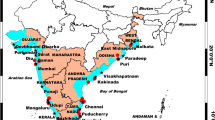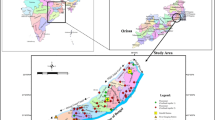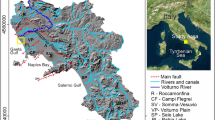Abstract
Worldwide, coastal aquifers are threatened by seawater intrusion. The threat is greatest when aquifers are overexploited or when recharge is low due to a semi-arid or arid climate. The Kaluvelli-Pondicherry sedimentary basin in Tamil Nadu (India) presents both these characteristics. Groundwater levels in the Vanur aquifer can reach 50 m below sea level at less than 20 km inland. This groundwater depletion is due to an exponential increase in extraction for irrigation over 35 years. No seawater intrusion has yet been detected, but a sulphate-rich mineralization is observed, the result of upward vertical leakage from the underlying Ramanathapuram aquifer. To characterize the mechanisms involved, and to facilitate effective water management, hydrogeological numerical modelling of this multi-layered system has been conducted. Existing and acquired geological and hydrodynamic data have been applied to a quasi-3D hydrogeological model, NEWSAM. Recharge had been previously quantified through the inter-comparison of hydrological models, based on climatological and surface-flow field measurements. Sensitivity tests on parameters and boundary conditions associated with the sea were performed. The resulting water balances for each aquifer led to hypotheses of (1) an offshore fresh groundwater stock, and (2) a reversal and increase of the upward leakage from the Ramanathapuram aquifer, thus corroborating the hypothesis proposed to explain geochemical results of the previous study, and denying a seawater intrusion. Palaeo-climate review supports the existence of favourable hydro-climatological conditions to replenish an offshore groundwater stock of the Vanur aquifer in the past. The extent of this fresh groundwater stock was calculated using the Kooi and Groen method.
Résumé
Dans le monde entier, les aquifères côtiers sont menacés par des intrusions marines. La menace est plus grande lorsque les aquifères sont surexploités ou lorsque la recharge est faible en raison d’un climat semi-aride ou aride. Le bassin sédimentaire de Kaluvelli-Pondichéry au Tamil Nadu (Inde) présente ces deux caractéristiques. Les niveaux d’eau souterraine dans l’aquifère de Vanur peuvent atteindre 50 m sous le niveau de la mer à moins de 20 km à l’intérieur des terres. Cet épuisement des eaux souterraines est dû à une augmentation exponentielle des prélèvements pour l’irrigation depuis 35 ans. Aucune intrusion marine n’a encore été détectée, mais une minéralisation riche en sulfate est observée, résultant d’une drainance ascendante depuis l’aquifère sous-jacent, celui de Ramanathapuram. Afin de caractériser les mécanismes impliqués, et de faciliter une gestion efficace de l’eau, une modélisation hydrogéologique numérique de ce système multicouches a été menée. Les données géologiques et hydrodynamiques existantes et acquises ont été appliquées à un modèle hydrogéologique quasi-3D, NEWSAM. La recharge avait été préalablement quantifiée par l’inter-comparaison de modèles hydrologiques, basés sur des mesures de terrain climatologiques et de débit de surface. Des tests de sensibilité ont été effectués sur les paramètres, et sur les conditions aux limites associées à la mer. Les bilans hydriques obtenus pour chaque aquifère ont conduit à deux hypothèses: (1) un stock offshore d’eau douce souterraine, et (2) un renversement et une augmentation de la drainance provenant de l’aquifère de Ramanathapuram, corroborant ainsi l’hypothèse proposée pour expliquer les résultats géochimiques de l’étude précédente, et niant une intrusion marine. La synthèse bibliographique paléo-climatique soutient l’existence de conditions hydro-climatiques favorables à la reconstitution du stock d’eau souterraine offshore au sein de l’aquifère de Vanur dans le passé. L’étendue de ce stock d’eau douce souterraine a été calculée en utilisant la méthode de Kooi et Groen.
Resumen
A nivel mundial, los acuíferos costeros están amenazados por la intrusión de agua de mar. La amenaza es mayor cuando los acuíferos están sobreexplotados o cuando la recarga es baja debido a un clima semiárido o árido. La cuenca sedimentaria de Kaluvelli-Pondicherry en Tamil Nadu (India) presenta ambas características. Los niveles de agua subterránea en el acuífero Vanur pueden alcanzar 50 m bajo el nivel del mar a menos de 20 km en el interior. Este agotamiento del agua subterránea se debe a un aumento exponencial de la extracción para el riego durante 35 años. No se ha detectado ninguna intrusión de agua de mar, pero se observa una mineralización rica en sulfato, resultado de una filtración vertical ascendente desde el acuífero subyacente de Ramanathapuram. Para caracterizar los mecanismos involucrados, y para facilitar una gestión eficaz del agua, se ha realizado un modelo hidrogeológico numérico en este sistema multicapa. Se han aplicado los datos geológicos e hidrodinámicos existentes y adquiridos en un modelo hidrogeológico cuasi-3D, NEWSAM. La recarga había sido previamente cuantificada a través de la comparación de modelos hidrológicos, basados en mediciones climatológicas y de flujo superficial de campo. Se realizaron pruebas de sensibilidad de los parámetros y de las condiciones de contorno asociadas con el mar. Los balances hídricos resultantes para cada acuífero llevaron a las hipótesis de (1) una reserva subterránea dulce mar adentro, y (2) una inversión y aumento de la filtración ascendente desde el acuífero de Ramanathapuram, corroborando así la hipótesis propuesta para explicar los resultados geoquímicos de un estudio previo, y rechazando una intrusión de agua de mar. La revisión paleoclimática apoya la existencia de condiciones hidro-climatológicas favorables para reponer en el pasado la reserva de agua subterránea del acuífero de Vanur. La extensión de esta reserva de agua subterránea dulce se calculó usando el método Kooi y Groen.
摘要
世界范围内的沿海含水层受到了海水入侵的威胁。当含水层超采或由于半干旱或干旱气候造成补给降低时,威胁最大。(印度)泰米尔纳德邦Kaluvelli-Pondicherry沉积盆地展示了这两种特征。Vanur含水层地下水位在不到20公里的内陆可达海平面之下50米。地下水的枯竭是由于过去35年来灌溉抽水指数增加造成的。还没有检测到海水入侵,但观测到了富硫酸盐矿化作用,这是下伏Ramanathapuram含水层向上垂直越流造成的。为了描述所涉及到的机理,以及促进有效的水管理,对这个多层系统进行了水文地质数值模拟。把现有的和获得的地质和水动力数据应用到一个准-3D水文地质模型中,即NEWSAM模型。先前,根据气候和地表水流野外测量结果,通过水文地质模型的相互比较对补给量进行了量化。对与海洋相关的参数和边界条件进行了灵敏度测试。结果显示,每个含水层水平衡导致以下假设:(1)近海地下淡水有库存;(2)从Ramanathapuram含水层向上的越流出现反转和增加,因此,证实了提出的解释过去研究的地球化学结果的假设,否定了存在着海水入侵。古气候回顾支持存在着过去补给Vanur含水层地下水库存的有利水文-气候条件。采用Kooi 和 Groen方法计算了这个地下水淡水库存的范围。
Resumo
Em todo o mundo, os aquíferos costeiros são ameaçados pela intrusão de água do mar. A ameaça é maior quando os aquíferos são sobreexplotados ou quando a recarga é baixa devido a um clima semiárido ou árido. A bacia sedimentar Kaluvelli-Pondicherry em Tamil Nadu (Índia) apresenta ambas as características. Os níveis das águas subterrâneas no aquífero de Vanur podem atingir 50 m abaixo do nível do mar a menos de 20 km no interior. Esta depleção das águas subterrâneas é devido ao aumento exponencial na extração para irrigação por 35 anos. Nenhuma intrusão de água do mar foi detectada ainda, mas observa-se uma mineralização rica em sulfato, resultado de uma fuga vertical ascendente a partir do aquífero subjacente de Ramanathapuram. Para caracterizar os mecanismos envolvidos, e para facilitar a gestão eficaz da água, foi realizada a modelagem hidrogeológica numérica deste sistema multicamadas. Os dados geológicos e hidrodinâmicos existentes e adquiridos foram aplicados a um modelo hidrogeológico quasi-3D, NEWSAM. A recarga foi previamente quantificada através da intercomparação de modelos hidrológicos, com base em medidas de campo climatológicas e superficiais. Foram realizados testes de sensibilidade em parâmetros e condições de contorno associados ao mar. Os balanços hídricos resultantes para cada aquífero levaram a hipóteses de (1) um estoque em alto mar de água subterrânea doce, e (2) uma inversão e aumento do fluxo vertical do aquífero Ramanathapuram, corroborando a hipótese proposta para explicar os resultados geoquímicos do estudo anterior, e negar uma intrusão de água do mar. A revisão do Paleoclima apoia a existência de condições hidroclimatológicas favoráveis para reabastecer o estoque de água subterrânea do aquífero de Vanur no passado. A extensão deste estoque de água subterrânea foi calculada usando o método de Kooi e Groen.






Similar content being viewed by others
References
Agarwal A, Narain S (1997) Dying wisdom (4th state of India’s environment). CSE, New Delhi, pp 242–263
Bourgeon G (1988) Esquisse sur les grandes zones de sols du sud de l’Inde [An overview of the main soils in southern India]. Cahiers ORSTOM Sér Pédol 24(4):303–328
CGWB (1984) Tamil Nadu State Central Ground Water Board, 1/250 000 map, area covered: from the Kaluvelli swamp in the north to the Gingee River in the south. CGWB, Faridabad, India
Chari MVN, Sahu JN, Banerjee B, Zutshi PL, Chandra K (1995) Evolution of the Cauvery basin, India from subsidence modelling. Mar Pet Geol 12(6):667–675
Coudrain A, Talbi A, Leoudx E, Loubet M, Vacher J, Ramirez E (2001) Subsurface transfer of chloride after a lake retreat in the Central Andes. Ground Water 39(5):751–759
d’Ozouville N, Violette S, Gassama N, Dia A, Jendrzejewski N (2006) Origin and modelling of water salinization in a coastal aquifer of the Bay of Bengal: The Kaluvelly watershed, Tamil Nadu, India. Bull Soc Geol Fr 177(6):333–345. doi:10.2113/gssgfbull.177.6.333
de Marsily G (1986) Quantitative hydrogeology. Elsevier, Amsterdam
Edijatno, Nascimento ND, Yang XL, Makhouf Z, Michel C (1999) GR3J: a daily watershed model with three free parameters. Hydrol Sci J 44(2):263–277. doi:10.1080/02626669909492221
Gassama N, Dia A, Violette S (2012) Origin of salinity in a multilayered aquifer with high salinization vulnerability. Hydrol Process 26(2):168–188. doi:10.1002/hyp.8125
Geng QZ, Girard G, Ledoux E (1996) Modeling of nitrogen cycle and nitrate transfer in regional hydrogeologic systems. Ground Water 34(2):293–304
Geological Survey of India (1995) Geological and mineral map of Tamil Nadu and Pondichery, 1/500 000, Geological Data Base 1984, Geological Survey of India, Kolkata
Ghassemi F, Jakeman AJ, Nix HA (1995) Salinisation of land and water resources: human causes, extent, management, and case studies, chap 6. CAB, Wallingford, UK, pp 291–337
Girard G, Ledoux E, Villeneuve JP (1980) Modèle intégré pluie: eau de surface–eau souterraine [An integrated rainfall: surface-water and groundwater model]. La Houille Blanche (4/5):315–320
Glover RE (1959) The pattern of fresh water flow in a costal aquifer. J Geophys Res 64:457–459
Grasby SE, Chen Z, Issler D, Stasiuk L (2009) Evidence for deep anaerobic biodegradation associated with rapid sedimentation and burial in the Beaufort-MacKenzie Basin, Canada. Appl Geochem 24(4):536–542
Groen J, Velstra J, Meesters ACGA (2000) Salinization processes in paleowaters in coastal sediments of Suriname: evidence from DELTAA37Cl analysis and diffusion modelling. J Hydrol 234:1–20
Gvt of India (1979) Report on 1975 piezometric survey. GOI, New Delhi
Habets F, Boone A, Champeaux JL, Etchevers P, Franchistéguy L, Lebois E, Ledoux E, Le Moigne P, Martin E, Morel S, Noihan J, Quintana Segui P, Rousset-Regimbeau F, Viennot P (2008) The SAFRAN-ISBA-MODCOU hydrometeorological model applied over France. J Geophys Res 113. doi:10.1029/2007JD008548
Habtemichael YT, Fuentes HR (2016) Hydrogeochemical analysis of processes through modeling of seawater intrusion impacts in Biscayne Aquifer water quality, USA. Aquat Geochem 22(3):197–209. doi:10.1007/s10498-016-9287-1
Hameed A, Achyuthan H, Sekhar B (2006) Radiocarbon dates and Holocene sea-level change along the Cuddalore and Odinur Coast, Tamil Nadu Coast, Tamil Nadu. Curr Sci 91(3):362–367
Hataway JC et al (1979) Unites States Geological Survey core drilling on the Atlantic shelf. Science 206:515–527
Jaya Kumar B, Chandra PC, Veeranjaneyulu D, Adil MD, Narayana Raju V, Tata SN (1984) Hydrogeological conditions in Auroville. Internal report, CGWB, Faridabad, India, 124 pp
Jayakumar R, Siraz L (1997) Factor analysis in hydrogeochemistry of coastal aquifers: a preliminary study. Environ Geol 31(3–4):174–177
Jost A, Violette S, Gonçalves J, Ledoux E, Guyomard Y, Guillocheau F, Kageyama M, Ramstein G, Suc JP (2007) Long-term hydrodynamic response induced by past climatic and geomorphologic forcing: the case of the Paris basin, France. Phys Chem Earth 32(1–7):368–378. doi:10.1016/j.pce.2006.02.053
Kooi H, Groen J (2001) Offshore continuation of coastal groundwater systems; predictions using sharp-interface approximations and variable-density flow modelling. J Hydrol 246(1–4):19–35. doi:10.1016/S0022-1694(01)00354-7
Kooi H, Groen J, Leijnse A (2000) Modes of seawater intrusion during transgression. Water Resour Res 36(12):3581–3589
Kwong HT, Jiao JJ (2016) Hydrochemical reaction and origin of offshore relatively fresh pore water from core samples in Hong Kong. J Hydrol 537:283–296
Lacarce E, Fleutry L (2001) Étude des sols du bassin versant de Kaluvelly [Soil study of the Kaluvelly watershed]. Mémoire de fin d’école d’ingénieur (ENSAR). ENSAR, Rennes, France, 22 pp
Larabi A, Hilali M, Sbai MA (1999) Investigation of the groundwater salinization in the Martil coastal aquifer (Tetouan – Morocco). Natuurwetenschappelijk Tidjschrift 79(1–4): 263–267
Ledoux E (1986) Modèles mathématiques en hydrogéologie [Mathematical models in hydrogeology]. LHM/RD – 86/12, Centre d’Informatique Géologique, Ecole Nationale Supérieure des Mines de Paris
Levassor A, Ledoux E (1996) Technical report. Ecole des Mines de Paris-CIG, France
Malone MJ, Claypool G, Martin JB, Dickens GR (2002) Variable methane fluxes in shallow marine systems over geologic time: the composition and origin of pore waters and authigenic carbonates on the New Jersey shelf. Mar Geol 189(3–4):175–196
Mosse D (2003) The rule of water: statecraft, ecology and collective action in South India. Oxford University Press, New Delhi, 337 pp
Mukundan TM (1988) The Erys systems of South India. PPST Bull 16:37
Person M, Marksamer A, Dugan B et al (2012) Use of a vertical δ18O profile to constrain hydraulic properties and recharge rates across glacio-lacustrine unit, Nantucket Island, Massachusetts, USA. Hydrogeol J 20:325–336
Ponton C, Giosan L, Eglinton TI et al (2012) Holocene aridification of India. Geophys Res Lett 39:L03704
Post VEA, Groen J, Kooi H, Person M, Ge SM, Edmunds WM (2013) Offshore fresh groundwater reserves as a global phenomenon. Nature 504(7478):71–78. doi:10.1038/nature12858
Ramesh R, Kumar KS, Eswaramoorthi S, Purvaja GR (1995) Migration and contamination of major and trace elements in groundwater of Madras city, India. Environ Geol 25(2):126–136
Sankari TS, Chandramouli AR, Gokul K, Sury SSM, Saravanavel J (2015) Coastal vulnerability mapping using geospatial technologies in Cuddalore-Pichavaram coastal tract, Tamil Nadu, India. Aquat Procedia 4:412–418. doi:10.1016/j.aqpro.2015.02.055
Shah T, Singh OP, Mukherji A (2006) Some aspects of South Asia’s groundwater irrigation economy: analyses from a survey in India, Pakistan, Nepal Terai and Bangladesh. Hydrogeol J 14(3):286–309. doi:10.1007/s10040-005-0004-1
Singh A, Misra BK, Singh BD, Navale GKB (1992) The Neyveli lignite deposits (Cauvery basin), India: organic composition, age and depositional pattern. Int J Coal Geol 21(1–2):45–97
Subramanian KS, Selvan TA (2001) Geology of Tamil Nadu and Pondicherry. Geological Society of India, Bangalore
Sukhija BS, Reddy DV, Vasanthakumar Reddy I (1987) Survey of groundwater resources of Pondicherry and its environs. Internal report, NGRI, Hyderabad, India
Sukhija BS, Reddy DV, Nagabhushanam P et al (1996) Environmental and injected tracers methodology to estimate direct precipitation. J Hydrol 177:77–97
Sukhija BS, Reddy DV, Nagabhushanam P (1998) Isotopic fingerprints of paleoclimates during the last 30,000 years in deep confined groundwaters of southern India. Quat Res 50(3):252–260. doi:10.1006/qres.1998.2001
Sundaram R, Henderson RA, Ayyasami K, Stilwell JD (2001) A lithostratigraphic revision and palaeoenvironmental assessment of the Cretaceous system exposed in the onshore Cauvery Basin, southern India. Cretac Res 22:743–762. doi:10.1006/cres.2001.0287
Thornthwaite CW, Mather JR (1957) Instructions and tables for computing potential evapotranspiration and the water balance, 5th edn., vol 10. Thornthwaite, Laboratory of Climatology, Elmer, UK
Vaz GG (2000) Age of relict coral reef from the continental shelf of Karaikal, Bay of Bengal: evidence of Last Glacial Maximum. Curr Set 79(2):228–230
Veerappan (2002) Groundwater perspectives: a profile of Villupuram district, Tamil Nadu. Internal report, insert, SG SWRDC, Chennai, India
Vincent A (2007) Etude hydrologique et hydrogéologique du bassin sédimentaire côtier de Kaluvelli-Pondichéry, Tamil Nadu, Inde [Hydrological and hydrogeological study of the coastal sedimentary basin of Kaluvelli-Pondichéry, Tamil Nadu, India]. PhD Thesis, Paris 6 University, France
Vincent A, Violette S, de Marsily G, Jorcin P, Sivasubramanian K, Krisnamurti RS (2006) Infiltration quantification at the watershed scale using hydrological models, in a semi-arid context (Kaluvelly-Pondicherry coastal sedimentary basin, Pondicherry territories and Tamil Nadu state, India), Geophysical Research Abstracts, vol 8, 04401, European Geosciences Union, Munich, Germany
Violette S, Vincent A, de Marsily G, Boulicot G (2003) HELP Basin Proposal Document: bassin de Kaluvelli-Pondichéry, Inde [Kaluvelli-Pondicherry Basin, India]. UNESCO, Paris, 26 pp
Violette S, Boulicot G, Gorelick SM (2009) Tsunami-induced groundwater salinization in southeastern India. C R Geosci 341:339–346. doi:10.1016/j.crte.2008.11.013
Zeng X, Wu J, Wang D et al (2016) Assessing the pollution risk of a groundwater source field at western Laizhou Bay under seawater intrusion. Environ Res 148:586–594. doi:10.1016/j.envres.2015.11.022
Acknowledgements
We would like to thank the French Ministère de la Recherche et l’Enseignement Supérieur for Aude Vincent PhD grant, as well as Naturalia et Biologia association and the Ensemble Foundation for field work funding. This project was supported by the UNESCO-HELP program. Thanks go to Auroville Water Harvest director Gilles Boulicot, and all the team, especially Krisnamurti RS, Pierre Jorcin and Selvam Jayaraman, who kindly provided logistical support during field work and GIS data treatment. Thanks also go to Nicolas Da Silva Maïa for 2016 monitoring of Aurogreen well, to Sophie Pietrucci, who assisted with the English in this report, and to two anonymous reviewers, whose comments helped to greatly improve the manuscript.
Author information
Authors and Affiliations
Corresponding author
Rights and permissions
About this article
Cite this article
Vincent, A., Violette, S. Why seawater intrusion has not yet occurred in the Kaluvelli-Pondicherry basin, Tamil Nadu, India. Hydrogeol J 25, 1893–1907 (2017). https://doi.org/10.1007/s10040-017-1558-4
Received:
Accepted:
Published:
Issue Date:
DOI: https://doi.org/10.1007/s10040-017-1558-4




